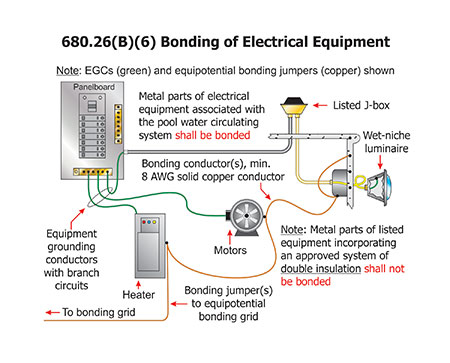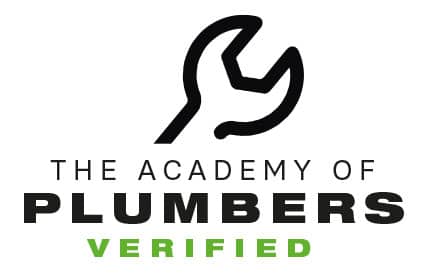Bonding and Grounding cause some confusion. Bonding involves the copper wire from your pool that runs on the outside of your equipment, whereas grounding is the green wire that comes from your electrical panel. Our blog on electricity, Electricity, and water a shockingly good time?, will give you more insight and several links that may help you understand the importance and difference of the bonding and grounding code requirements. Nec 2017 code will require bonding of the pool water also. (Examples from CMP)
Electrical Bonding Code (NEC)
680.26 Equipotential Bonding (common bonding grid )
(A) Performance – The required equipotential bonding is intended to reduce voltage gradients in the area around a permanently installed pool.
(5) Metal Fittings – Metal fittings 4 in. and larger located within or
attached to the pool structure, such as ladders and handrails, must be
bonded to the equipotential grid.
- All electric equipment associated with a recirculating system of the pool.
- All metal parts of the pool structure, including the reinforcing metal of the pool shell, coping stones, and deck.
- All forming shells.
- All metal fittings within or attached to the pool structure.
- Metal parts of electric equipment associated with the pool water circulating system. Pool heater, pump motors, metal covers on auto covers.
- Metal conduit, metal piping, and all fixed parts that are within 5 feet of the inside walls of the pool and that are not separated from the pool by a permanent barrier. Art. 680-22.
- These parts shall be connected to a common bonding grid with a solid copper conductor, insulated, covered or bare, not smaller than No. 8. The connection shall be made by pressure connectors or clamps of brass, copper or copper alloy.
Where a permanently installed pool installed at a dwelling unit at least one 120-volt receptacle shall be installed a minimum of 10 feet from and no more than 20 feet from the inside wall of the pool. Art. 680-22. It shall be on a ground fault interrupter. Article (680.22). This receptacle is in addition to a receptacle for the pump.
THE FOLLOWING EQUIPMENT SHALL BE GROUNDED
- Wet-niche underwater lighting fixtures.
- Dry-niche underwater lighting fixtures.
- All electric equipment within 5 feet of the inside walls of the pool.
- All electric equipment associated with a recirculating system of the pool.
- Junction boxes.
- Transformer enclosures.
- Ground fault circuit interrupters.
What does bonding do?
Bonding is defined as: ” the practice of intentionally electrically connecting all exposed metallic items not designed to carry electricity in a room or building as protection from electric shock.” (Wikipedia) In other words: ” it is that the primary purpose of bonding is to keep people and electricity separated”. Electrical gradients (stray currents) can occur in a swimming pool. Every metal component, the pool water, and your body are all conductive and will carry electricity. In an improperly bonded pool, stray currents are out of control and will seek the easiest path for conductivity. A bonded pool balances the electrical pressure and keeps all currents flowing outward into a bonding wire or grid where they are safely dispersed.




